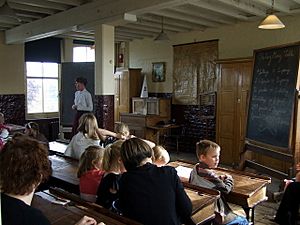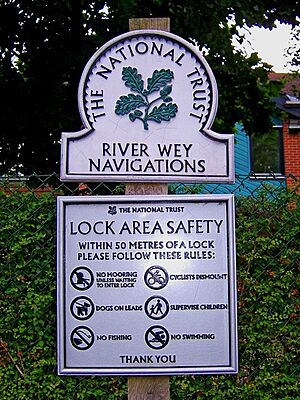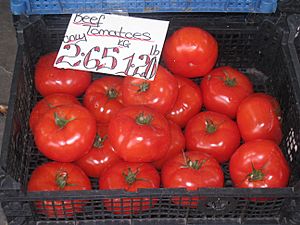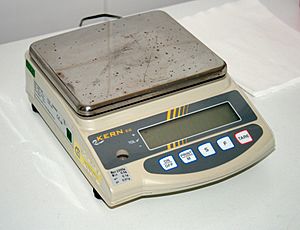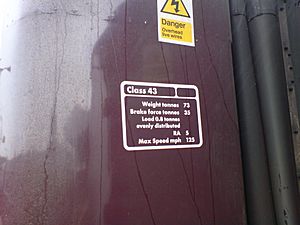Metrication in the United Kingdom facts for kids
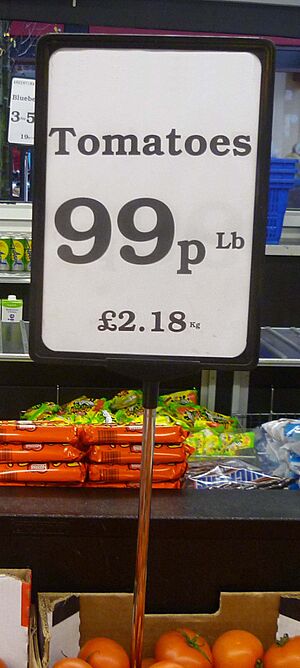
Have you ever wondered why some things in the United Kingdom are measured in miles and pints, while others use kilograms and litres? This is because the UK has been slowly changing from using old-fashioned imperial units to the metric system. This change is called metrication.
Most of the UK government, businesses, and industries now use metric units. However, you still see imperial units for things like how far you travel (miles), how fast cars go (miles per hour), and the size of milk bottles or glasses of beer (pints). People also often use imperial units to talk about their height and weight, or how much fuel a car uses. In schools, kids learn and use metric units, but they also learn about the common imperial units.
Contents
How Metrication Started
Early Ideas for Measurement
People in the UK started talking about using the metric system a long time ago, even in 1818! By the mid-1960s, some industries and government groups were already starting to use metric measurements.
In 1965, the government officially decided to support metrication. This was because businesses asked for it. The idea was that companies would switch to metric on their own, and they would cover the costs.
In 1969, the government created the Metrication Board. This group was set up to help promote and organize the switch to metric.
Changes and Challenges
At first, the government wanted the change to be voluntary. But in 1978, some shops started going back to selling things by the old imperial measurements. So, the government decided to make metrication mandatory for some products.
However, in 1980, the government changed its mind again, preferring voluntary metrication. The Metrication Board was then closed down. By this time, most parts of the economy had switched to metric, except for road signs and some parts of shops.
When the UK joined the European Economic Community (EEC) in 1973, it agreed to use a specific set of metric units for many things within five years. By 1980, most pre-packaged goods were sold using metric units.
It became mandatory to use metric units for packaged goods in 1995 and for loose items (like fruit and vegetables) in 2000. At first, shops were only allowed to show imperial units alongside metric ones for a short time. But because people didn't like the change, this rule was extended many times. Finally, in 2009, the rule that would have stopped shops from using imperial units alongside metric ones was removed. So, you can still see both today!
British Scientists and Metrication
British scientists, thinkers, and engineers played a big part in developing the metric system. For example, in 1861, a group of scientists, including Lord Kelvin and James Clerk Maxwell, defined electrical units using the metric system. In the 1870s, a British company called Johnson, Matthey & Co even made the official international prototype metre and kilogram.
History of Measurements
Before 1799: Different Measures
When King James I became king of England in 1603, England and Scotland had different ways of measuring things. Even though many units had the same names, their sizes were different. For example, a Scottish pint was more than twice the size of an English pint!
In 1707, when England and Scotland joined to form Great Britain, English measurements became the standard. But Scottish measures were still used until a law in 1824 made them illegal.
This time was known as the Age of Enlightenment, when people used logic to improve society and knowledge. British thinkers helped create ideas for a decimal system (based on 10), which later became the foundation of the metric system.
One of the first decimal measuring tools was Gunter's chain, invented in 1620 by Edmund Gunter. This chain was 100 links long, making it easy to measure land area in acres.
In 1783, the Scottish inventor James Watt suggested creating a worldwide decimal measurement system. In 1790, France invited Britain to help create such a system. Britain was interested, but when France decided to use a different way to define the metre (based on the Earth's size), Britain pulled out. France continued alone and created the system we now call the Système International d'Unités, which is used by most of the world.
1799–1962: Debates and Discoveries

In 1851, the Great Exhibition in London showed how difficult it was to compare things from different countries because of all the different measurement systems. This led to calls for a standard system across Europe, and the metric system was suggested.
In 1863, a law that would have made the metric system mandatory across the British Empire was rejected because it seemed impractical. The next year, a weaker law was passed that only made it legal to use the metric system in contracts.
While politicians debated, British scientists were busy developing the system. In 1845, James Prescott Joule showed that mechanical and heat energy were related. This idea is key to the metric system, where power is measured in watts and energy in joules, no matter what type of energy it is.
In 1861, a group of scientists, including Lord Kelvin and James Clerk Maxwell, decided that electrical energy should be measured using the metric system and have the same units as mechanical energy. They also introduced the idea of a "coherent system of units," where units like length, mass, and time were "fundamental units," and all other units could be derived from them.
In 1873, another group of scientists recommended the CGS (centimetre-gram-second) system for scientific work. They also named the units for force and energy: "dyne" and "erg."
In 1875, many countries met in Paris and signed the Metre Convention, setting up international organizations to oversee weights and measures. The UK didn't sign at first, but later did in 1884. In 1889, official metric standards (a metre and a kilogram) were given to the countries that signed the treaty.
In 1896, a law was passed that made metric units legal for all purposes in the UK, but not compulsory. In 1902, an Empire conference decided that metrication should be mandatory across the British Empire. In 1904, Lord Kelvin led a campaign for metrication, collecting 8 million signatures! But a group called the British Weights and Measures Association was formed to oppose the change.
The idea of compulsory metrication was put aside because of wars and economic problems. It wasn't brought up again until 1951, when a report strongly recommended making metrication and decimal currency mandatory within ten years. The report said the UK should choose between keeping two systems or getting rid of the old imperial one.
Metrication from 1962 Onwards
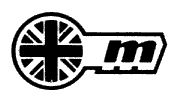
In 1962, the British Standards Institution (BSI) started talking about metrication. By 1963, they believed that changes in measurement were unavoidable and that the metric system should become the main system in the UK as soon as possible.
In 1965, British industries told the government they wanted to adopt the metric system. The government agreed to support a ten-year plan for metrication. The plan was mostly voluntary, meaning businesses would switch on their own, and they would pay for the changes.
The BSI led the effort to change technical standards to metric units. They worked with international organizations to make sure British standards matched global ones.
There were three main ways metrication happened:
- Hard metrication: This meant creating new products based on round metric sizes. For example, A4 paper (a metric size) replaced older paper sizes.
- Soft metrication: This meant simply rewriting existing standards using metric units, without changing the product's actual size.
- New measurement methods: Sometimes, the old ways of measuring were outdated, so new metric-based methods were introduced. For example, the strength of alcohol is now measured as a percentage of alcohol by volume.
The Metrication Board

In 1968, the government announced that a Metrication Board would be set up to manage the change, aiming to finish by the end of 1975. The board was made up of people from business, industry, education, and consumer groups. The Metrication Board was officially set up in December 1968, with Lord Ritchie-Calder as its chairman. By this time, much of the preparation work, like rewriting British Standards, was already done.
Government Policy Changes
After a new government was elected in 1970, some politicians complained that metrication was being introduced secretly. So, the government decided to publish a report to look at the costs, benefits, and problems of switching to the metric system.
The report, published in 1972, explained why metrication was needed. It said that metric units had been legal since 1897, so it wasn't a secret introduction. It also said that joining the European Common Market would require metrication, and that British industries exporting worldwide would benefit. The report hoped that metrication would be mostly complete within ten years and that people would slowly get used to the metric system.
Soon after, the plan to change speed limits to metric in 1973 was postponed. But other parts of the metrication program continued. Many industries, like electric cable makers, the paint industry, and the steel industry, completed their switch to metric by the mid-1970s. However, the goal of finishing by 1975 was not met.
Education and Learning
In England and Wales, local councils managed education. In 1967, the Department for Education told all schools to prepare for the metric system. In science, this meant switching from the old CGS system to SI units. In geography, it meant using metric instead of imperial. In maths, it meant no longer teaching complicated calculations with mixed units, which used to take up a lot of time in primary schools.
In Scotland, almost all exams from 1973 onwards used SI units, especially for science and engineering. In England, different exam boards had their own timelines. Students faced challenges because new teaching methods were also being introduced at the same time, and there wasn't much national coordination.
In 1988, the National Curriculum was introduced in England, Wales, and Northern Ireland. This curriculum made SI the main system for measurement and calculations. However, it also said that students should learn about common imperial measurements and their approximate metric equivalents. Scotland has its own education system, and it also teaches the metric system.
Shops and Consumers
The retail industry was a tough area for the Metrication Board. Shops didn't see much benefit in switching, and competition was high.
Many parts of the retail industry did agree to a plan. But in 1977, a carpet shop went back to selling carpets by the square yard instead of the square metre, making it seem cheaper. This showed that laws were needed to make metrication happen, rather than just relying on voluntary changes.
Most of the retail industry switched to metric in 1977 and 1978 through new laws. By 1980, 95% of common foods were sold in metric quantities.
When the Metrication Board closed in 1980, an agreement was made with the EEC to allow some imperial measures until 1989, which was later extended to 1999. By then, most pre-packaged goods were metric, but loose goods (like fruit and vegetables) were still sold in imperial units. In 1999, the UK government allowed the permission to use imperial units to expire. This meant that almost all goods (except beer, cider, and milk in returnable containers) had to be priced in metric units.
Petrol started being sold by the litre instead of the gallon after the Metrication Board closed. This happened because old petrol pumps couldn't show prices above £1.999 per gallon. By switching to litres, the price per unit became much lower (about 4.5 times less), so the pumps could still be used.
Today, in the UK, only draught beer and cider cannot be sold in metric units. They are sold in pints (or fractions of a pint). Other alcoholic drinks, like spirits and wine, are sold in metric measures (millilitres).
Other Areas of Change

Even before the official metrication program, some organizations were already switching. For example, the Ordnance Survey, which makes maps for Great Britain, started using metric measures in 1936. From World War II onwards, their maps used a metric grid. In 1964, the Ordnance Survey decided to go fully metric.
The Met Office, which reports on weather, started giving temperatures in both Celsius and Fahrenheit in 1962, and stopped using Fahrenheit in official reports in 1970.
Many other industries also switched to metric in the late 1960s and early 1970s. This wasn't always obvious to the public, but you could see metric prices in financial newspapers for things like metals.
Costs of Metrication
The British metrication program was voluntary, so businesses were supposed to cover their own costs. Because of this, it's hard to know the exact total costs and savings. Companies often installed new metric equipment as part of their regular maintenance, rather than as a special metrication project. For example, new gas meters measure in cubic metres, but older ones still measure in cubic feet.
One study in the 1970s estimated that the chemical industry's costs were about £6 million over seven years. Many companies said they made their money back within a year because their production improved.
About 85% of UK exports go to countries that use the metric system. It costs businesses extra to maintain two production lines: one for exports to the US (which uses imperial units) and one for domestic sales and exports to the rest of the world (which use metric). These costs have been estimated to be very high.
In 1978, the cost of changing road signs from miles to kilometres was estimated to be between £7.5 million and £8.5 million. A 2005 report said that changing the UK's two million road signs would be the biggest cost to finish metrication.
Rules and Regulations
European Laws and UK Units
Historically, UK laws about weights and measures only applied to trade. But when the UK joined the European Economic Community (EEC), it had to follow EEC rules. These rules included a directive that required the UK to officially define many units of measure in law, such as the ampere (for electric current) and the volt (for electric potential).
Because many people opposed metrication, the program slowed down. In the late 1970s, the UK government asked the EEC to delay the deadlines for using metric units. This led to a new directive that allowed the UK to continue using many imperial units for trade until the end of 1989 (later extended to 1995).
By the end of 1988, the permission to use imperial units was extended until the end of 1994, and until the end of 1999 for selling loose goods. From 1995, many pre-packaged foods had to be sold in specific metric quantities.
From January 1, 2000, most loose goods sold by weight, volume, or length (like potatoes or cheese cut in front of the customer) had to be priced and measured using metric units.
The acre was officially replaced by the hectare for land registration in 2010, following an EU rule. However, the acre is still used alongside the hectare.
Since 2010, the only non-metric units still allowed by UK law without extra metric indicators for business, public health, safety, or administration are:
- The mile, yard, foot, and inch for road signs, distance, and speed.
- The imperial pint for draught beer and cider, and for selling milk in returnable containers.
- The troy ounce for trading in precious metals.
If goods or services are sold by a description (e.g., a "6 foot by 6 foot" fence panel) rather than a price per unit, they are not covered by these laws. But a pole sold as "50 pence per linear foot" without a metric price would be illegal.
Showing Both Units
Because the UK and Ireland were switching to metric, a rule was added that allowed any unit of measure to be followed by a "supplementary indicator" (the old unit), as long as it wasn't bigger or more noticeable than the metric unit. This rule was supposed to end in 1989, but it was extended until 2009. When the rule was reviewed in 2009, this "sunset clause" was removed, meaning shops can continue to show both metric and imperial units.
The EU rule doesn't say which units can be used as supplementary indicators, but British law limits them to specific imperial units for trade.
It's also common to see imperial packaging sizes marked with metric units. For example, many jars of jam are marked 454 grams, which is exactly one imperial pound.
Consumers can still ask for goods using imperial units. And because shops can use dual-measure scales, a customer can see an imperial price, ask for an imperial quantity, and still be sold the correct metric equivalent.
Weighing Machines
In the 1990s, new laws were introduced to make sure UK weighing devices matched those in other EEC countries. For example, the weight shown on pre-packaged goods changed in 1980 to show the average weight of items in a batch, not the guaranteed minimum weight of each item.
A new EU rule for weighing instruments came into force in 2006. It set standards for weighing devices used in trade, medicine, or for court evidence. These devices must be checked regularly and show SI units.
This means that most shops in the UK cannot legally use weighing devices that only show imperial units. In 2000, after the deadline for selling loose produce by imperial units passed, some market traders continued to use imperial-only scales. They were taken to court for using illegal scales. Five traders, known as the Metric Martyrs, lost their appeals in various courts.
A report in 2010 recommended that hospitals should use accurate metric-only scales for safety reasons.
How Well Did Metrication Work?
After the UK government's report on metrication was published in 1972, a science journal said that the government wasn't pushing the issue hard enough. It said that the UK would become a "dual country" using both systems.
Studies by US government agencies in the 1970s noted that the British metrication program lacked strong leadership from the government. This meant:
- The Metrication Board wasn't set up early enough, so industries had to lead the change without enough support for the retail sector.
- The government didn't provide enough funding; industries paid for most of the initial work themselves.
- There was no clear "champion" for metrication in the government.
- The belief that the program could be done only voluntarily was wrong; laws were needed to keep it on track.
The Metrication Board's final report agreed with these points.
Because the European Commission was involved, metrication became linked with Euroscepticism (being against the European Union). Some British newspapers that were against the EU often exaggerated or made up stories about forced metrication. For example, one newspaper falsely claimed that beer would soon have to be sold by the litre in pubs.
A 2004 report called A Very British Mess by the UK Metric Association received mixed reactions. Some said that public dislike of the metric system was due to a lack of understanding, not because it was "foreign." Others said that going back to the imperial system was impossible and that the current situation (using both) was costly.
A 2007 survey found that many people opposed switching entirely to metric measurements. The biggest difference in opinion was between readers of tabloid newspapers and broadsheet newspapers, rather than by age or social class.
What's Used Today?
In its final report in 1980, the Metrication Board said that metric units were used in many important areas of British life, including education, farming, construction, and most manufacturing. They also said that most pre-packaged foods, postal services, and new maps used metric units. However, they concluded that Britain was "far from being wholly metric." The report pointed out that retail petrol sales (which switched in 1984), retail sales of loose goods (which switched in 2000), and road signs (which have not switched) were still imperial.
Shops Today
From January 1, 2000, laws made it mandatory to use metric units for most products sold in shops, although shops could still show imperial units as extra information. Some rules, like wine being sold in 750 ml bottles, came from EU directives. Other rules, like bread being sold in 400 g or 800 g loaves, were only for the UK.
However, a new EU rule in 2007 removed many of these specific packaging size requirements for most products, except for wines and liqueurs. This meant that a lot of the Metrication Board's work on specific sizes was undone. But the laws about how products are labelled (showing metric units) have stayed the same.
Government and Transport
Government organizations like the Office for National Statistics and the Ordnance Survey use metric units in their work.
For transport, things like railway tracks were "soft metricated." For example, the standard railway track width, which was 4 feet 8.5 inches, was redefined as 1,435 mm – a tiny change within engineering limits.
Motorway marker posts used by road maintenance and emergency services show locations in multiples of 100 metres. New road and rail vehicles are designed using metric standards. However, road and railway signs still use imperial units, except for new railways like the Channel Tunnel Rail Link and modern tram systems, which use metric. The London Underground uses metric units for distances but not for speeds.
Apart from petrol sales, which switched to metric in the 1980s, drivers haven't seen much metrication. Speedometers and car fuel consumption figures are given in both metric and imperial units. Road signs show distances and speed limits only in imperial units.
Public Opinion
Surveys on Understanding and Use
A 2013 survey asked people about their understanding and use of metric and imperial units. The results showed:
- Half of the people surveyed were against completing metrication, while a quarter supported it.
- Younger people were more supportive than older people, but still, 36% of 18–24 year olds were against it.
- Most people preferred to use metric units when there were practical reasons to do so.
- However, for things like personal weight, all age groups, including younger people, still commonly used imperial units.
- Even though many people opposed metrication, it wasn't a major issue that would affect how they voted in elections.
A 2021 survey looked at preferred measurement systems by age group for six different situations. It found:
- Younger people tended to prefer metric units, but they still preferred imperial units for measuring a person's height, speed, and long distances.
- Younger people preferred metric units for short distances and weighing items.
- However, 18-29 year olds were almost equally divided on how to weigh a person, with 47% using stones and pounds and 44% using kilograms.
Groups for and Against Metrication
There are groups that support either the metric or the imperial system:
- Active Resistance to Metrication: This group is known for protesting against metric signs.
- The British Weights and Measures Association: This group campaigns to keep imperial measurements in the UK.
- The UK Metric Association: This group campaigns for the UK to fully switch to the metric system.
After Brexit
After the UK left the European Union on January 31, 2020, it is no longer bound by EU rules for trade in England, Scotland, and Wales. In September 2021, a government minister announced that the UK would review the rules that require most goods for sale to use metric weights.
Images for kids
-
Gunter's chain – an early British measuring tool based on a decimal system.
-
Joule's heat apparatus from 1845, used in his work on energy.
-
A warning sign on an NHS hospital trolley showing the maximum permitted weight.


